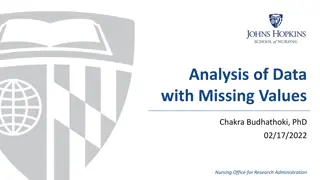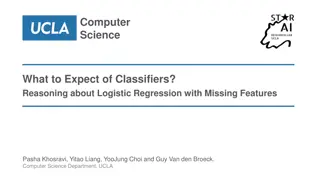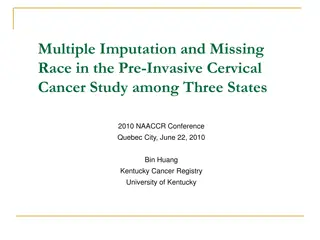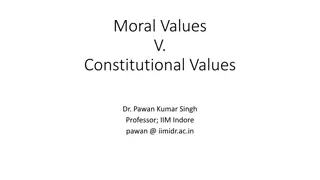
Effective Strategies for Handling Missing Values in Data Analysis
Learn about the impact of missing values in data analysis, different mechanisms, simple and advanced approaches for handling them, and the importance of making assumptions to choose the right treatment method.
Download Presentation

Please find below an Image/Link to download the presentation.
The content on the website is provided AS IS for your information and personal use only. It may not be sold, licensed, or shared on other websites without obtaining consent from the author. Download presentation by click this link. If you encounter any issues during the download, it is possible that the publisher has removed the file from their server.
E N D
Presentation Transcript
Dealing with Missing Values 1. Introduction 2. Assumptions and Missing Data Mechanisms 3. Simple Approaches to Missing Data 4. Maximum Likelihood Imputation Methods 5. Machine Learning Based Methods 6. Experimental Comparative Analysis
Dealing with Missing Values 1. Introduction 2. Assumptions and Missing Data Mechanisms 3. Simple Approaches to Missing Data 4. Maximum Likelihood Imputation Methods 5. Machine Learning Based Methods 6. Experimental Comparative Analysis
Introduction A missing value (MV) is just a value for attribute that was not introduced or was lost in the recording process: Equipment errors Manual data entry procedures Incorrect measurements
Introduction MVs make performing data analysis difficult Also inappropriate handling of the MVs in the analysis may introduce bias and can result in misleading conclusions Problems are usually associated with MVs: 1. loss of efficiency; 2. complications in handling and analyzing the data; 3. bias resulting from differences between missing and complete data.
Introduction Usually the treatment of MVs in DM can be handled in three different ways: Discarding the examples with MVs. Deleting attributes with elevated levels of MVs is included in this category too. Using maximum likelihood procedures, where the parameters of a model for the data are estimated, and later used for imputation by means of sampling. Imputation of MVs is a class of procedures that aims to fill in the MVs with estimated ones, as attributes are not independent from each other
Dealing with Missing Values 1. Introduction 2. Assumptions and Missing Data Mechanisms 3. Simple Approaches to Missing Data 4. Maximum Likelihood Imputation Methods 5. Machine Learning Based Methods 6. Experimental Comparative Analysis
Assumptions and Missing Data Mechanisms It is important to categorize the mechanisms which lead to the introduction of MVs The assumptions we make about the missingness mechanism can affect which treatment method could be correctly applied, if any
Assumptions and Missing Data Mechanisms In most problems, the data is arranged in a rectangular data matrix, where MVs can appear as shown next:
Assumptions and Missing Data Mechanisms If we consider the i.i.d. assumption, the probability function of the complete data can be written as follows: Where f is the probability function for a single case and represents the parameters of the model that yield such a particular instance of data.
Assumptions and Missing Data Mechanisms The parameters values for the given data are very rarely known! We can consider distributions that are commonly found in nature: multivariate normal distribution (only real values) multinomial model (nominal attributes) mixed models for combined normal and categorical features
Assumptions and Missing Data Mechanisms The parameters values for the given data are very rarely known! We can consider distributions that are commonly found in nature: multivariate normal distribution (only real values) multinomial model (nominal attributes) mixed models for combined normal and categorical features
Assumptions and Missing Data Mechanisms X = (Xobs, Xmis), We call Xobsthe observed part of X We denote the missing part as Xmis Let s suppose that we dispose of a matrix B of the same size of X B values are 0 o 1 when X elements are missing and missing respectively.
Assumptions and Missing Data Mechanisms The distribution of B should be related to X and to some unknown parameters , so we dispose a probability model for B described by P(B|X, ). Having a missing at random (MAR) assumption means that this distribution does not depend on Xmis:
Assumptions and Missing Data Mechanisms MAR does not suggest that the missing data values constitute just another possible sample from the probability distribution. This condition is known as missing completely at random (MCAR). MCAR is a special case of MAR in which the distribution of an example having a MV for an attribute does not depend on either the observed or the unobserved data
Assumptions and Missing Data Mechanisms Under MCAR, the analysis of only those units with complete data gives valid inferences Although there will generally be some loss of information MCAR is more restrictive than MAR MAR requires only that the MVs behave like a random sample of all values in some particular subclasses defined by observed data.
Assumptions and Missing Data Mechanisms A third case arises when MAR does not apply as the MV depends on both the rest of observed values and the proper value itself. This model is usually called not missing at random (NMAR) or missing not at random (MNAR) in the literature. The only way to obtain an unbiased estimate is to model the missingness as well. This is a very complex task in which we should create a model accounting for the missing data that should be later incorporated to a more complex model used to estimate the MVs.
Dealing with Missing Values 1. Introduction 2. Assumptions and Missing Data Mechanisms 3. Simple Approaches to Missing Data 4. Maximum Likelihood Imputation Methods 5. Machine Learning Based Methods 6. Experimental Comparative Analysis
Simple Approaches to Missing Data They usually do not take into account the missingness mechanism and they blindly perform the operation.
Simple Approaches to Missing Data The most simple approach is to do not impute (DNI). the MVs remain unreplaced, so the DM algorithm must use their default MVs strategies if present An alternative for these learning methods that cannot deal with MVs, another approach is to convert the MVs to a newvalue (encode them into a new numerical value). Such a simplistic method has been shown to lead to serious inference problems
Simple Approaches to Missing Data A very common approach in the specialized literature, even nowadays, is to apply case deletion or ignore missing (IM) All instances with at least one MV are discarded from the data set. Under the assumption that data is MCAR, it leads to unbiased parameter estimates but even when the data are MCAR there is a loss in power using this approach
Simple Approaches to Missing Data The substitution of the MVs for the global most common attribute value for nominal attributes, and global average value for numerical attributes (MC) is widely used A variant of MC is the concept most common attribute value for nominal attributes, and concept average value for numerical attributes (CMC) The MV is replaced by the most repeated one if nominal or is the mean value if numerical, but considers only the instances with the same class as the reference instance. Drawback: the covariance in the imputed data set will be severely altered if the amount of MVs is considerable
Dealing with Missing Values 1. Introduction 2. Assumptions and Missing Data Mechanisms 3. Simple Approaches to Missing Data 4. Maximum Likelihood Imputation Methods 5. Machine Learning Based Methods 6. Experimental Comparative Analysis
Maximum Likelihood Imputation Methods Rubin et al. formalized the concept of missing data introduction mechanisms and they advised against use case deletion as a methodology (IM) An ideal and rare case would be where the parameters of the data distribution were known A sample from such a distribution (conditioned or not to the other attributes values) would be a suitable imputed value for the missing one. The problem is that the parameters are rarely known and also very hard to estimate
Maximum Likelihood Imputation Methods An alternative is to use the maximum likelihood to estimate the original So the next question arises: to solve a maximum likelihood type problem, can we analytically maximize the likelihood function? it can work with one dimensional Bernoulli problems like the coin toss it also works with onedimensional Gaussian by finding the and parameters
Maximum Likelihood Imputation Methods Can we analytically maximize the likelihood function? In real world data things are not that easy. We can have distribution that may not be well behaved or have too many parameters making the actual solution computationally too complex. Having a likelihood function made of a mixture of 100 100-dimensional Gaussians would yield 10,000 parameters and thus direct trial-error maximization is not feasible.
Maximum Likelihood Imputation Methods Can we analytically maximize the likelihood function? In real world data things are not that easy. The way to deal with such complexity is to introduce hidden variables in order to simplify the likelihood function and, in our case as well, to account for MVs. The observed variables are those that can be directly measured from the data hidden variables influence the data but are not trivial to measure An example of an observed variable would be if it is sunny today, whereas the hidden variable can be P(sunny today|sunny yesterday).
Maximum Likelihood Imputation Methods Even simplifying with hidden variables does not allow us to reach the solution in a single step. The most common approach in these cases would be to use an iterative approach in which we obtain some parameter estimates, we use a regression technique to impute the values and repeat
Expectation-Maximization (EM) In a nutshell the EM algorithm estimates the parameters of a probability distribution. It iteratively maximizes the likelihood of the complete data Xobsconsidered as a function dependent of the parameters
Expectation-Maximization (EM) That is, we want to model dependent random variables as the observed variable a and the hidden variable b that generates a We stated that a set of unknown parameters governs the probability distributions P (a), P (b) As an iterative process, the EM algorithm consists of two steps that are repeated until convergence: the expectation (E-step) and the maximization (M-step) steps.
Expectation-Maximization (EM) The E-step tries to compute the expectation of logP (y, x): where are the new distribution parameters. Multiplying several probabilities will soon yield a very small number and thus produce a loss of precision in a computer due to limited digital accuracy A typical solution is then to use the log of these probabilities and to look for the maximum log likelihood
Expectation-Maximization (EM) How can we find the that maximizes Q? Remember that we want to pick a that maximizes the log likelihood of the observed (a) and the unobserved (b) variables given an observed variable a and the previous parameters The conditional expectation of logP (b, a) given a and is
Expectation-Maximization (EM) The key is that if then P (a) > P (a) If we can improve the expectation of the log likelihood, EM is improving the model of the observed variable a.
Expectation-Maximization (EM) In any real world problem, we do not have a single point but a series of attributes x1, . . . , xn Assuming i.i.d. we can sum over all points to compute the expectation:
Expectation-Maximization (EM) The EMalgorithm is not perfect: it can be stuck in local maxima and also depends on an initial value The latter is usually resolved by using a bootstrap process in order to choose a correct initial Also the reader may have noticed that we have not talked about any imputation yet. The reason is EM is a meta algorithm that it is adapted to a particular application
Expectation-Maximization (EM) To use EM for imputation first we need to choose a plausible set of parameters We need to assume that the data follows a probability distribution drawback The EM algorithm works better with probability distributions that are easy to maximize Gaussian mixture models In each iteration of the EM algorithm for imputation the estimates of the mean and the covariance are represented by a matrix and revised in three phases These parameters are used to apply a regression over the MVs by using the complete data.
Multiple Imputation (MI) One big problem of the maximum likelihood methods like EM is that they tend to underestimate the inherent errors produced by the estimation process, formally standard errors. The Multiple Imputation (MI) approach was designed to take this into account to be a less biased imputation method, at the cost of being computationally expensive.
Multiple Imputation (MI) MI is a Monte Carlo approach in which we generate multiple imputed values from the observed data in a very similar way to the EM algorithm it fills the incomplete data by repeatedly solving the observed data But a significative difference between the two methods is attained: EM generates a single imputation in each step from the estimated parameters at each step, MI performs several imputations that yield several complete data sets Data Augmentation (DA)
Multiple Imputation (MI) This repeated imputation can be done thanks to the use of Markov Chain Monte Carlo methods Several imputations are obtained by introducing a random component, usually from a standard normal distribution
Multiple Imputation (MI) In a more advanced fashion, MI also considers that the parameters estimates are in fact sample estimates The parameters are not directly estimated from the available data but, as the process continues, they are drawn from their Bayesian posterior distributions given the data at hand These assumptions means that only in the case of MCAR or MAR missingness mechanisms hold MI should be applied.
Multiple Imputation (MI) Due to its Bayesian nature, the user needs to specify a prior distribution for the parameters of the model In practice is stressed out that the results depend more on the election of the distribution for the data than the distribution for
Multiple Imputation (MI) Surprisingly not many imputation steps are needed Rubin claims that only 3 5 steps are usually needed He states that the efficiency of the final estimation built upon m imputations is approximately where is the fraction of missing data in the data set.
Multiple Imputation (MI) With a 30% of MVs in each data set, which is a quite high amount, with 5 different final data sets a 94% of efficiency will be achieved Increasing the number to m = 10 slightly raises the efficiency to 97%, which is a low gain paying the double computational effort.
Multiple Imputation (MI) With a 30% of MVs in each data set, which is a quite high amount, with 5 different final data sets a 94% of efficiency will be achieved Increasing the number to m = 10 slightly raises the efficiency to 97%, which is a low gain paying the double computational effort.
Multiple Imputation (MI) To start we need an estimation of the mean and covariance matrices. A good approach is to take them from a solution provided from an EM algorithm once their values have stabilized at the end of its execution Then the DA process starts by alternately filling the MVs and then making inferences about the unknown parameters in a stochastic fashion: 1. DA creates an imputation using the available values of the parameters of the MVs 2. Draws new parameter values from the Bayesian posterior distribution using the observed and missing data Concatenating this process of simulating the MVs and the parameters is what creates a Markov chain that will converge at some point
Multiple Imputation (MI) The iterative process will converge: The distribution of the parameters will stabilize to the posterior distribution averaged over the MVs The distribution of the MVs will stabilize to a predictive distribution: the proper distribution needed to drawn values for the MIs. Large rates of MVs in the data sets will cause the convergence to be slow
Multiple Imputation (MI) However, the meaning of convergence is different to that used in EM In EM the parameter estimates have converged when they no longer change from one iteration to the following over a threshold In DA the distribution of the parameters do not change across iterations but the random parameter values actually continue changing, which makes the convergence of DA more difficult to assess than for EM
Multiple Imputation (MI) Convergence is reinterpreted in MI: DA can be said to have converged by k cycles if the value of any parameter at iteration t 1, 2, . . . is statistically independent of its value at iteration t + k The DA algorithm usually converges under these terms in equal or less cycles than EM.
Multiple Imputation (MI) The value k is interesting: it establishes when we should stop performing the Markov chain in order to have MI that are independent draws from the missing data predictive distribution. A typical process is to perform m runs, each one of length k for each imputation from 1 to m we perform the DA process during k cycles It is a good idea not to be too conservative with the k value, as after convergence the process remains stationary, whereas with low k values the m imputed data sets will not be truly independent. Remember that we do not need a high m value, so k acts as the true computational effort measure.






















